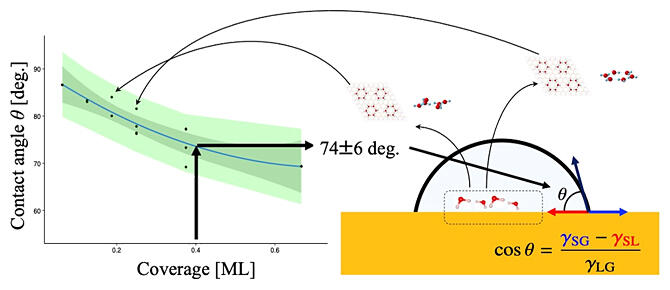A research group led by Associate Professor Kenta Hongo of the Sustainable Innovation Research Area, Research Center for Advanced Computing Infrastructure, Japan Advanced Institute of Science and Technology (JAIST), and Professor Ryo Maezono and Assistant Professor Kousuke Nakano, also of JAIST (at the time of research), has successfully developed a technique to statistically estimate the water contact angle of a typical copper surface by integrating simulation and data science in order to identify wettability phenomena on the metal surface.
Wetting, the affinity or repellence to water, is a familiar natural phenomenon in everyday life and plays a role in many industrial fields. If wetting can be estimated via simulation, material surfaces can be designed with wettability without experimentation, which will facilitate product development. Wettability can be quantitatively evaluated as the angle (contact angle) θ formed by water droplets on the surface and is classified into hydrophobic (water repellent) and hydrophilic depending on the magnitude of θ with respect to the right angle. However, it is not just the number of atoms and water molecules constituting the surface and water droplets that is enormous, but also that the water molecules on the surface of solids have enormous structural degrees of freedom, such as relatively free movement among water droplets and formation of groups (clusters). As such, the whole system of solid surfaces and water droplets with enormous degrees of freedom could not be handled in a simulation.
The research group initially calculated the contact angle using an ice model, but as an alternative, they adopted a typical cluster structure model and statistically estimated the contact angle by treating the contact angle data obtained using first-principles calculations in data science. They first created scatter plots of the contact angle and coverage, and through regression analysis (a method of estimating variables in data based on statistics), created a statistical regression model to describe the contact angle as a function of coverage. They could estimate the contact angle, albeit with statistical error, by substituting a known coverage factor (~0.4) for this regression model. The estimate they obtained (74 ± 6°) fell within the range of the experimental measurements and the error was smaller than the variation of the experimental results (60~87°), which resulted in quantitatively highly accurate results.

Provided by JAIST
Since this coverage is not known for all metal surfaces, they estimated the contact angle and its error using statistical sampling. They obtained an estimated contact angle (78 ± 4°), which was in good agreement with the aforementioned estimated value. With this approach, the researchers could statistically estimate the contact angle using this simulation data, even for metal surfaces with unknown coverage.
"In our research, we were able to solve the problem with statistical analysis," explained Hongo. "The wettability of metal surfaces is an important issue not only for copper, but also for catalyst applications and other industrial applications, so we are looking to apply and develop this technology for other types of metal surfaces."
Journal Information
Publication: Surfaces and Interfaces
Title: Ab-initio-based interface modeling and statistical analysis for estimate of the water contact angle on a metallic Cu (111) surface
DOI: 10.1016/j.surfin.2022.102342
This article has been translated by JST with permission from The Science News Ltd. (https://sci-news.co.jp/). Unauthorized reproduction of the article and photographs is prohibited.




